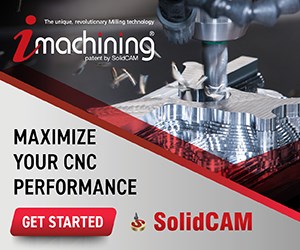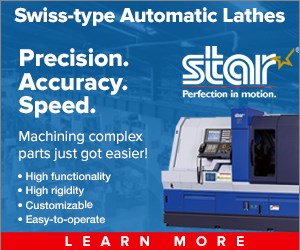Carbon Fiber Spindles Aim to Eliminate Grinding Variance
These spindles available on Tschudin CNC centerless grinders are designed to minimize the heat transfer factor while optimizing dimensional stability and material removal rate.

Development partner Carbon-Drive GmbH, based in Weiterstadt, Germany, is Tschudin AG’s exclusive development and design partner for carbon fiber spindles in the centerless grinding sector. Source (all photos): Tschudin AG
Tschudin AG has reportedly developed the industry’s first carbon fiber grinding and regulating spindles to minimize the heat input of its Cube 350 centerless grinders.
Urs Tschudin, shareholder of Tschudin AG, says the Swiss company has been working consistently for three decades to greatly lower the heat transfer of its machines. He believes that the new spindles made from carbon fiber are the final puzzle piece, claiming the Cube 350 is the first grinding machine without heat transfer.
This is said to offer numerous advantages. By minimizing the heat cycle, production with consistent high accuracy can be assured at all times, the company says. Time-consuming machine warm-up — for example, on a Monday morning after a weekend sitting idle — is no longer necessary.
“Even if the machine stands still for a weekend, it can produce immediately within a maximum dimensional deviation of 1 micron,” Tschudin says. What’s more, all parts can be produced to the same dimensions even with multi-track grinding because the grinding and regulating wheels remain parallel given that thermal displacement is prevented. This enables the Cube 350 to work autonomously for a very long time as well as during unattended shifts.

The standard Cube 350 is fitted with steel grinding and regulating spindles, but carbon fiber spindles are now available as an option.
Development partner Carbon-Drive GmbH, based in Weiterstadt, Germany, is Tschudin AG’s exclusive development and design partner for carbon fiber spindles in the centerless grinding sector. Carbon-Drive emerged from a research project at the Technical University of Darmstadt. Co-founder and Managing Director Martin Klimach says carbon fiber spindles have various advantages, first and foremost is minimal thermal expansion. “Depending on the type of fiber and fiber orientation, we can produce carbon fiber spindles with different properties and thus respond to customers’ process requirements,” he notes.
Tschudin and Klimach met at an industry event in 2019. At the time, Carbon-Drive GmbH was already working on milling spindles made from carbon fiber. The idea of using carbon fiber spindles in the grinding sector was one that both experts knew should be pursued, and the first grinding spindle was ready for testing and refinement at the end of 2023.
The carbon fiber spindles developed in collaboration with Carbon-Drive GmbH were tested and adapted for more than 6 months with promising results. “How materials react to heat has a major influence on precision manufacturing,” explains Nikolas Ernst, head of design at Tschudin AG. “The temperature resistance of carbon fiber is particularly high; carbon spindles therefore prevent thermal expansion in the machine. They are more dimensionally stable and have a higher bending stiffness.” This means they can run at higher in-feeds and in turn offer higher cutting performance. In a series of tests, the carbon fiber spindles have proven to be between 10 to 20% more effective than steel spindles, he notes.

Carbon fiber spindles available on the Cube 350 are designed to minimize the heat transfer factor while optimizing dimensional stability and material removal rate.
Tschudin explains that the Cube 350 equipped with carbon fiber spindles should be particularly appealing to manufacturers that have the highest demands in terms of quality and precision. “The more precisely parts have to be manufactured, the more interesting the grinding machine with optimum heat transfer becomes. This is because we can offer real added value here thanks to the greater dimensional stability and higher drive power.”
The Cube 350 is the latest Tschudin centerless grinding machine that is designed to produce parts as big as 20 mm in diameter, plunge grind parts as long as 150 mm and perform through-feed part grinding. The compact machine has a footprint of just 2.60 by 1.70 meters and has been developed specially for machining small components. It is said to offer an ergonomic design and can be operated from both the left and the right side. The Cube 350 can also be equipped with various automatic loading options and pre- and/or postprocess gaging. Plus, it takes only 6 minutes to change grinding and regulating wheels.
Tschudin believes the introduction of carbon fiber spindles is the final step in a decades-long development process. For example, the company has been using linear motors for 30 years. More than 25 years ago, machine beds made of solid natural granite were used, which heat up extremely slowly due to their large dimensions and inertia. In a further step, the grinding spindle slides were also designed as granite blocks (the vertical stop surface for the spindles led to a drastic reduction in heat transfer).
The standard version of the Cube 350 will continue to be equipped with steel spindles. The carbon fiber spindles are available as an option.
Related Content
Junker Grinding Machines Feature Modular Design
The Platform 3 series of modular grinding machines is designed to provide increased flexibility and cost-effectiveness.
Read MoreEmag Grinding Solutions Provide Precise Gear-Profile Grinding
The G 160 and G 250 gear-profile grinding machines provide short chip-to-chip times, intelligent axis concepts as well as thermal and mechanical stability.
Read MoreStuder S100 Grinding Machine For High-Precision, Flexible, Reliable Grinding
The machine is well suited for a wide range of internal, surface and external grinding applications, making it well suited for the entry-level market.
Read MoreTooth Flank Grinding Technology Minimizes EV Drive Noise
Drives for electric vehicles require gear components with tight tolerances and excellent surface finishes. Even minimal ripples in the surface of tooth flanks on shafts and gears can cause interference noise in drive performance.
Read MoreRead Next
5 Aspects of PMTS I Appreciate
The three-day edition of the 2025 Precision Machining Technology Show kicks off at the start of April. I’ll be there, and here are some reasons why.
Read MoreDo You Have Single Points of Failure?
Plans need to be in place before a catastrophic event occurs.
Read MoreA Tooling Workshop Worth a Visit
Marubeni Citizen-Cincom’s tooling and accessory workshop offers a chance to learn more about ancillary devices that can boost machining efficiency and capability.
Read More










.jpg;maxWidth=300;quality=90)











